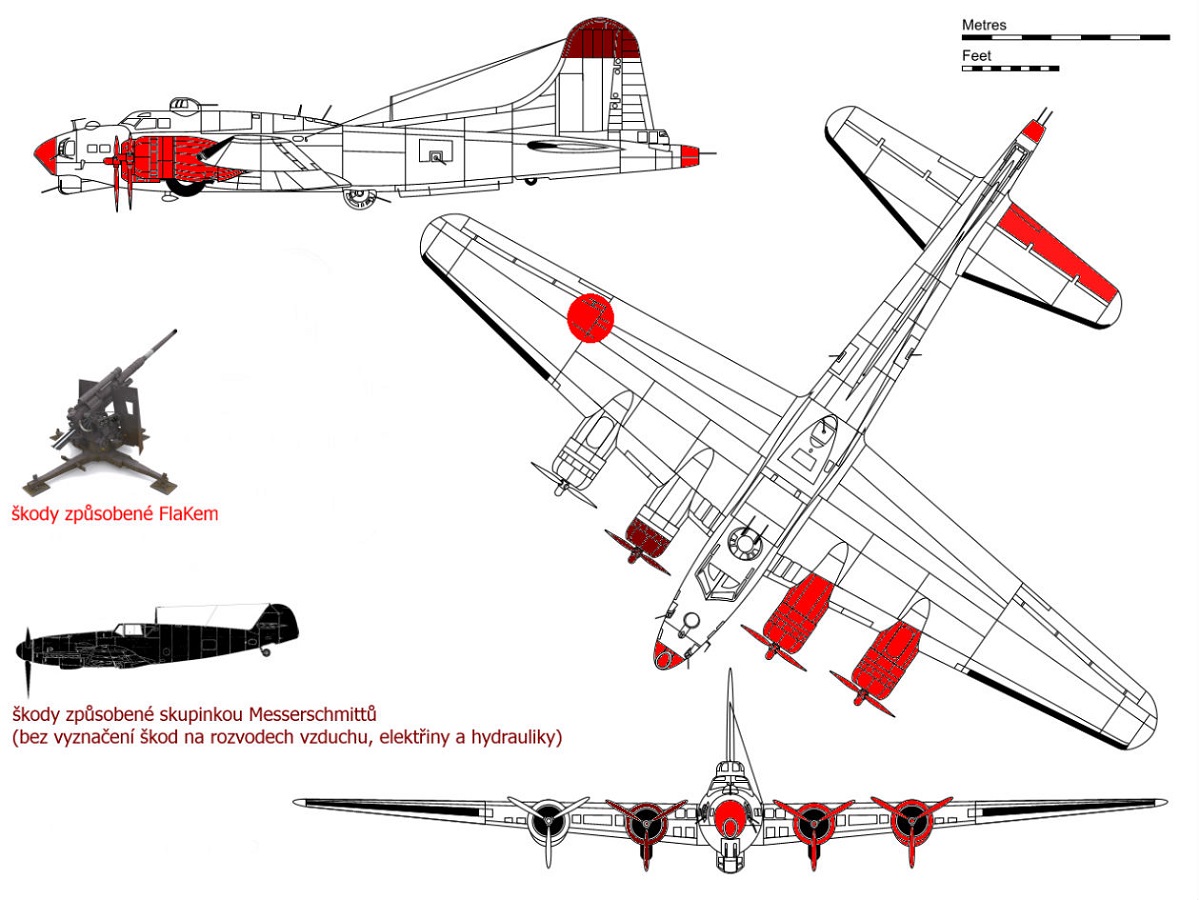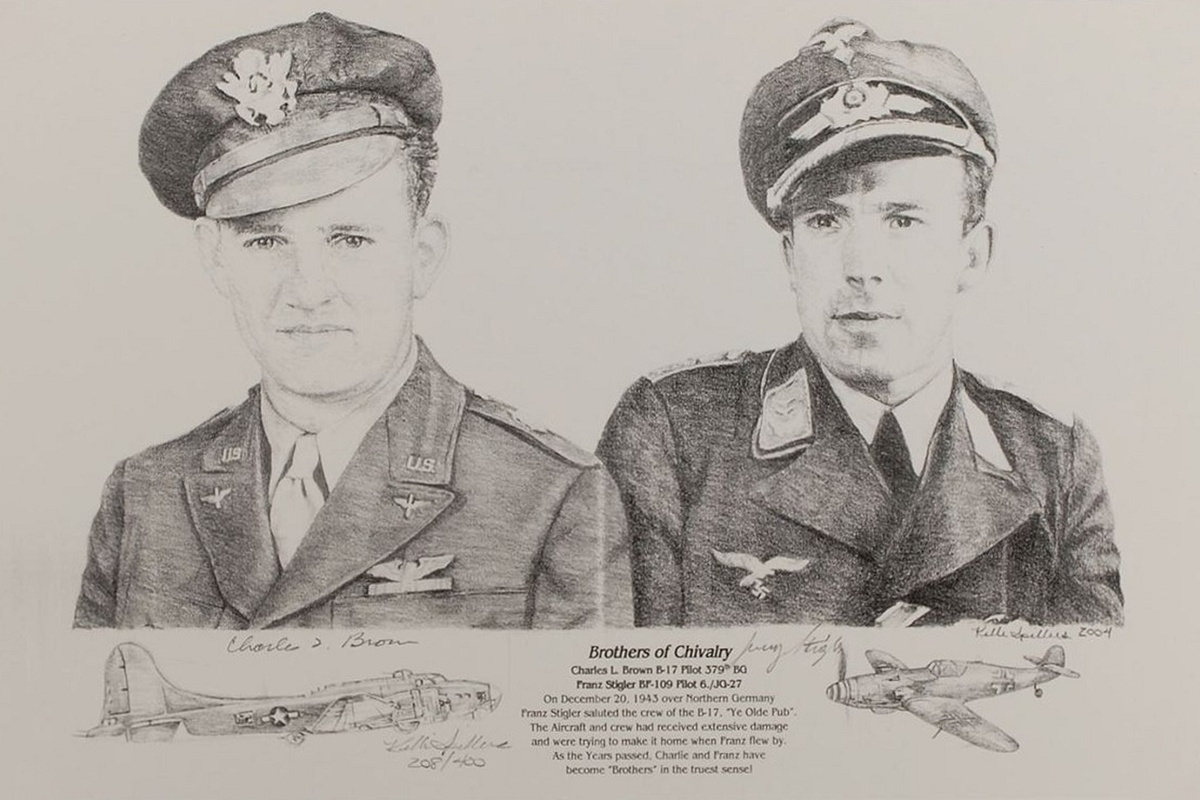This true story of 20. December 1943 proves that even in the greatest horrors II. world wars, some pilots still had the remnants of cavalry and moral ethics. On that day, the bombing of German Bremen, which was attended by the crew of a flying fortress with the nickname Ye Olde Pub. Allied bombers had to face a massive ground and air defense of the Focke-Wulf Fw 190 factory for the production of fighter aircraft.
 The crew mentioned then flew to its first combat mission, not knowing how this flight would change its life. Soon after their engine appeared over Bremen, it was heavily hit by anti-aircraft guns. As a result, it was hard to damage two engines, a dead rear shooter and the complete destruction of the front shooting point. Pilot, the young lieutenant Charles “Charlie” Brown decided to return and left the formation with the airplane. On the way back, the Ye Olde Pub briefly focused a group of German fighters to shoot it out of the sky. After this collision he stopped working on the already damaged airplane the third engine, air distribution, hydraulics and electricity and five other crew members were dead. By contrast, the Germans lost only one machine from the group, and one returned to a damaged one.
The crew mentioned then flew to its first combat mission, not knowing how this flight would change its life. Soon after their engine appeared over Bremen, it was heavily hit by anti-aircraft guns. As a result, it was hard to damage two engines, a dead rear shooter and the complete destruction of the front shooting point. Pilot, the young lieutenant Charles “Charlie” Brown decided to return and left the formation with the airplane. On the way back, the Ye Olde Pub briefly focused a group of German fighters to shoot it out of the sky. After this collision he stopped working on the already damaged airplane the third engine, air distribution, hydraulics and electricity and five other crew members were dead. By contrast, the Germans lost only one machine from the group, and one returned to a damaged one.
Charlie himself, for the sake of oxygen deficiency, was likely to fain for a while, turning his machine into an uncontrollable rush to the ground. Fortunately, he got back in time, and at a height of 600 meters and with his right-handed shoulder he got back over the airplane. Unfortunately, after this maneuver he lost his orientation and was not sure which direction he was flying, whether in England or within the enemy territory.
On the ground in the meantime, he was ordered to destroy the injured bomber Lieutenant Ludwig Franz Stigler, who had already received two air victories that day. He quickly took off with a stoning bullet of the .50 BMG in the cooler, risking overheating the engine, and soon caught up with Brown’s machine. However, when Stigler looked out of his cockpit, a machine impoverished by hostile interventions and a shot of Brown fighting the airplane, he could not believe it. At that moment he remembered the words of Gustav Rödel, the commander who served in North Africa:
You are the pilots, from beginning to end and always. If I ever hear of one of you shooting a guy on a parachute, I’ll shoot him myself.
He then decided to take off the crew of the US airplane and waving his wings to show her to follow him. But since Brown and the rest of the crew did not know the German pilot was trying to bring them to neutral Sweden, they kept on flying. After Stigler discovered that his effort had no effect, he flopped back to the side of the debris, where he remained without signs of any activity. Charlie understood his intentions when he saw the shores of England in the distance. Above the North Sea, Lieutenant Stigler saluted the crew, waved the wings of his Messerschmitt, and returned to northern Germany.
Upon returning to his base, he announced the downsizing of the machine over the sea, and the truth of the flight never told anyone. Charlie Brown and the rest of his crew eventually succeeded, though with great difficulty landing at RAF Seething Airport near Norwich in Norfolk, England. After the landing, the machine was already in such a desperate state that it had never been repaired and returned to active service. The entire survivor’s incident was described by the crew in her report, however, she was ordered to remain silent about the incident, so that no positive view of the German pilots would arise. Later on, Charles Brown made this statement:
Someone has decided that you can not be human and fly in the German cockpit.
After the war, Lieutenant Brown returned home to West Virginia, where he received high school education. In 1949, he returned to the Air Force and then worked in 1965-72 at the Foreign Ministry. He eventually moved to Miami and became an inventor. After the war, Franz Stigler moved to Canada near Vancouver, where he had been successful since 1953. In 1986, Colonel Charles Brown was then asked to take part in a combat pilots meeting called Eagle Fleet. At this event, for the first time since World War II, he spoke about the story of a German pilot who accompanied their crew back to England. After this meeting, Charlie decided to start searching for the mysterious pilot who saved his life at the time.
After four years of inexperienced search in the US and countless letters sent to various military organizations and societies, hope appeared in the form of a response to an ad published by Charlie in a newsletter for former German pilots. There was a brief correspondence between the two former pilots. In 1990, Brown finally again met Stigler again after almost fifty years. Since then, they have remained great friends until their death.
This story also featured the bestselling novel by Adam Makos, entitled A Higher Call, which was first published in December 2012. This May, Sir Tom Stoppard and a writer with Czech roots began to work with his son Wille to work on film adaptation of the same name. In the same year she introduced her new song inspired by this story as well as Swedish metal band Sabaton.
source:
http://en.wikipedia.org/wiki/Charlie_Brown_and_Franz_Stigler_incident
https://warthunder.com/cz/news/1046-letecké-eso-nadporučík-ludwig-franz-stigler-cz

